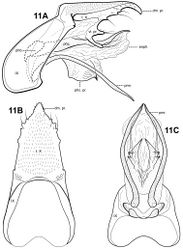Itauara flinti
| Notice: | This page is derived from the original publication listed below, whose author(s) should always be credited. Further contributors may edit and improve the content of this page and, consequently, need to be credited as well (see page history). Any assessment of factual correctness requires a careful review of the original article as well as of subsequent contributions.
If you are uncertain whether your planned contribution is correct or not, we suggest that you use the associated discussion page instead of editing the page directly. This page should be cited as follows (rationale):
Citation formats to copy and paste
BibTeX: @article{Robertson2011ZooKeys114, RIS/ Endnote: TY - JOUR Wikipedia/ Citizendium: <ref name="Robertson2011ZooKeys114">{{Citation See also the citation download page at the journal. |
Ordo: Trichoptera
Familia: Glossosomatidae
Genus: Itauara
Name
Itauara flinti Robertson & Holzenthal sp. n. – Wikispecies link – ZooBank link – flinti Pensoft Profile
Description
This species is known only from the male holotype. It is diagnosed by a unique combination of male genitalic characters and can be recognized by the shape of the phallicata process. Itauara flinti is most similar to Itaura charlotta sp. n., by having similarly shaped parameres, but these species are easily separated based on differences in the shape of tergum X and the phallicata process. The elongate and downturned dorsomesal process of tergum X is similar to that of Itaura guarani (Angrisano 1993[1]), but the 2 species differ in the shape of the parameres and phallicata processes. The ventrolateral process of tergum X is similar to that of Itaura tusci sp. n. These species differ in the shape of the parameres, dorsomesal margins of tergum X, and phallicata processes.
Adult. Body, wings, and appendages pale or tawny brown in alcohol. Forewing relatively narrow, with margins nearly parallel, apex subacute. Forewing venation incomplete, with apical forks I, II, and III present; Sc and R1 distinct along their entire lengths; fork I petiolate, but with extremely short stem; fork II petiolate, stem about the same length as fork; fork III petiolate, stem longer than fork; Cu1 complete, reaching wing margin; Cu1 and Cu2 intersecting near anastomosis; row of erect setae present along Cu2; A3 absent; crossveins forming a relatively linear transverse cord; discoidal cell longer than Rs vein. Hind wing narrow and slightly scalloped past anastomosis; apical forks II and V present; Sc and R1 fused basally; A2 absent. Tibial spurs 1,4,4, foretibial spur extremely reduced and hairlike. Sixth sternal process thumb-like, apex rounded, associated with weak oblique apodeme posteriorly.
Male genitalia. Preanal and inferior appendages absent. Segment IX dorsally narrow, broad ventrally; anterior margin rounded; posterolateral margin lightly sclerotized; sternum IX without modification. Tergum X incompletely fused to tergum IX with membrane or lightly sclerotized region ventrolaterally; dorsomesal margin with single, downturned, elongate process; dorsolateral margin irregular and setose; ventrolateral margin with 2 pairs of processes, the upper a small lobe-like setose process, the lower an elongate finger-like process bearing a few elongate setae. Parameres present, paired, arising ventrobasally from fused endotheca and phallobase, sclerotized and rod-like, slender and elongate, downturned, curved basally, straight medially and distally, directed ventrally and inward, apex pointed. Phallobase reduced, lightly sclerotized. Phallicata forming a long, lightly sclerotized dorsal sheath, slightly sinuous, medially with pair of lightly sclerotized rounded lateral flanges projecting posteroventrally, ventrally with several sclerotized points, thorn-like apices directed inward. Endophallus membranous, enlarged and convoluted when invaginated, with 1 large upper lobe and 1 smaller lower lobe.
Material examined
Holotype male: BRAZIL: Sao Paulo: Parque Estadual de Campos do Jordão, Rio Galharada, 22°41'40"S, 045°27'47"W, 1530 m, 13–15.ix.2002 (Blahnik, Prather, Melo, Huamantinco) (UMSP000086388) (MZUSP).
Etymology
We are delighted to name this species for Dr. Oliver Flint, Jr. in honor of his numerous important contributions to Neotropical caddisfly taxonomy.
Original Description
- Robertson, D; Holzenthal, R; 2011: Revision of the Neotropical caddisfly genus Itauara Müller, 1888 (Trichoptera, Glossosomatidae) ZooKeys, 114: 41-100. doi
Other References
- ↑ Angrisano E (1993) Contribucíon al conocimiento del genero Antoptila Mosely (Trichoptera: Glossosomatidae). Revista de la Sociedad Entomológica Argentina 52:57-62.
Images
|
